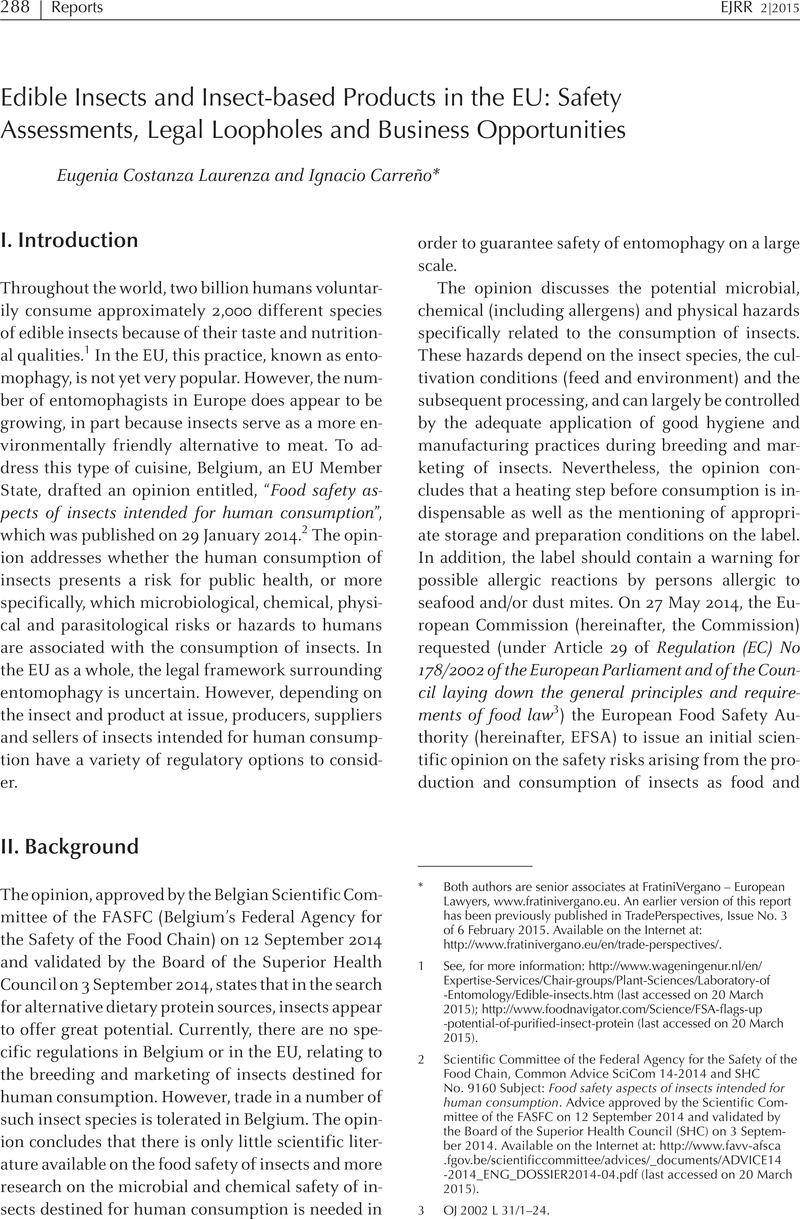Published online by Cambridge University Press: 20 January 2017

1 See, for more information: http://www.wageningenur.nl/en/Expertise-Services/Chair-groups/Plant-Sciences/Laboratory-of-Entomology/Edible-insects.htm (last accessed on 20 March 2015); http://www.foodnavigator.com/Science/FSA-flags-up-potential-of-purified-insect-protein (last accessed on 20 March 2015).
2 Scientific Committee of the Federal Agency for the Safety of the Food Chain, Common Advice SciCom 14-2014 and SHC No. 9160 Subject: Food safety aspects of insects intended for human consumption. Advice approved by the Scientific Committee of the FASFC on 12 September 2014 and validated by the Board of the Superior Health Council (SHC) on 3 September 2014. Available on the Internet at: http://www.favv-afsca.fgov.be/scientificcommittee/advices/_documents/ADVICE14-2014_ENG_DOSSIER2014-04.pdf (last accessed on 20 March 2015).
3 OJ 2002 L 31/1–24.
4 EFSA received the mandate from the Commission on the “Safety risks arising from the production and consumption of insects as food and feed”; Question Number: EFSA-Q-2014-00578, received on 27 May 2014, Request for an initial scientific opinion on the safety risks arising from the production and consumption of insects as food and feed. Deadline 30 September 2015.
5 Saisine n° 2014-SA-0153 12 février 2015. Avis de l’Agence nationale de sécurité sanitaire de l’alimentation, de l’environnement et du travail relatif à « la valorisation des insectes dans l’alimentation et l’état des lieux des connaissances scientifiques sur les risques sanitaires en lien avec la consommation des insectes».
6 OJ 2004 L/226.
7 OJ 2005 L 35/ 1–22.
8 OJ 1997 L 43/ 1–6.
9 Alison Gleadle, Emerging food technologies: novel protein sources as food, Food Standards Agency FSA, 15 November 2011, Available on the Internet at: http://www.food.gov.uk/sites/default/files/multimedia/pdfs/board/fsa111110.pdf (last accessed on 20 March 2015), at section 4.12.
10 Proposal for a Regulation of the European Parliament and of the Council on novel food, 18 December 2013, COM(2013) 894 final.
11 See statements of the FASFC, available on the Internet at: http://www.favv.be/foodstuffs/insects/ (last accessed on 20 March 2015), and of the FPS Health, Food Chain Safety and Environment, available on the Internet at: http://www.gezondheid.belgie.be/eportal/foodsafety/19091496_EN?fodnlang=en#.U9ZN16O_H19 (last accessed on 20 March 2015).
12 Available on the Internet at: http://www.favv.be/foodstuffs/insects/_documents/2014-05-21_Circular_insects_version11_EN.pdf (last accessed on 20 March 2015).
13 Press release Réf : CS. 2014–584 : Les insectes comestibles non autorisés au Luxembourg, 22 December 2014.
14 Casu Marzu (aka Maggot Cheese), Huffington Post, 6 March 2014. Available on the Internet at: http://www.huffingtonpost.com/culture-magazine/casu-marzu-aka-maggot-che_b_5086446.html (last accessed on 20 March 2015). See also: Prodotto Tradizionale della Sardegna, Casu frazigu http://www.sardegnaagricoltura.it/documenti/14_43_20090430084713.pdf (last accessed on 20 March 2015).
15 Jane Byrne, FSA flags up potential of purified insect protein, 16 November 2011. Available on the Internet at: http://www.foodnavigator.com/Science/FSA-flags-up-potential-of-purified-insect-protein (last accessed on 20 March 2015).
16 Commission Regulation (EU) No 68/2013 of 16 January 2013 on the Catalogue of feed materials OJ 2013 L 29/1–64.
17 Whole or parts of terrestrial invertebrates, in all their life stages, other than species pathogenic to humans and animals; with or without treatment such as fresh, frozen, dried.
18 OJ 2009 L 300/1–33.
19 OJ 2001 L 147/1–40.
20 Annex IV of the TSE Regulation (EC) (as amended by Commission Regulation (EC) No 1292/2005); Regulation (EC) No 1923/2006; and Commission Regulation (EU) No 56/2013).
21 Annex I(5) of Commission Regulation (EU) No 142/2011 of 25 February 2011 implementing Regulation (EC) No 1069/2009 of the European Parliament and of the Council laying down health rules as regards animal by-products and derived products not intended for human consumption and implementing Council Directive 97/78/EC as regards certain samples and items exempt from veterinary checks at the border under that Directive, OJ 2011 L 54/1–254, defines processed animal proteins as “animal protein derived entirely from Category 3 material, which have been treated (…) so as to render them suitable for direct use as feed material or for any other use in feedingstuffs, including petfood, or for use in organic fertilisers or soil improvers”.
22 2013 Food and Agriculture Organisation of the United Nations (FAO) Forestry Paper No. 171 entitled “Edible insects: future prospects for food and feed security”. Available on the Internet at: http://www.fao.org/docrep/018/i3253e/i3253e.pdf (last accessed on 20 March 2015).
23 Commission Regulation (EU) No 56/2013 of 16 January 2013 amending Annexes I and IV to Regulation (EC) No 999/2001 of the European Parliament and of the Council laying down rules for the prevention, control and eradication of certain transmissible spongiform encephalopathies, OJ 2013 L 21/3-16.
24 Available on the Internet at: http://www.fao.org/docrep/018/i3253e/i3253e.pdf (last accessed on 20 March 2015).
25 Belluco, S. et al., Edible Insects in a Food Safety and Nutritional Perspective: A Critical Review. Comprehensive Reviews in Food Science and Food Safety, (2013) 12(3): 296–313.CrossRefGoogle Scholar
26 Food and Drug Regulations C.R.C., c. 870, consolidation, last amended on 7 November 2014.
27 Discussion paper: Regulatory frameworks influencing insects as food and feed, Compiled by Afton Halloran, updated by Christopher Münke and Afton Halloran, version: 12 May 2014, p. 27. Available on the Internet at: http://www.fao.org/forestry/39620-04ee142dbb758d9a521c619f31e28b004.pdf (last accessed on 20 March 2015).
28 Ibid.
29 See: http://www.gpo.gov/fdsys/pkg/USCODE-2010-title21/pdf/USCODE-2010-title21-chap9-subchapIV-sec348.pdf (last accessed on 20 March 2015).
30 People who are allergic to shellfish may also be allergic to insects.
31 Discussion paper: Regulatory frameworks influencing insects as food and feed, Compiled by Afton Halloran, updated by Christopher Münke and Afton Halloran, version: 12 May 2014, p. 30.
32 Nicholas Robinson, Insect proteins will take off, FoodManufacture of 24 September 2014. Available on the Internet at: http://www.foodmanufacture.co.uk/Supplements/Food-Ingredients-Health-Nutrition/Insect-foods-could-be-worth-230M (last accessed on 20 March 2015); Commercialising edible insects - How to market the impossible, New Nutrition Business, September 2014. Available on the Internet at: http://www.scoop.it/t/entomophagy-edible-insects-and-the-future-of-food/p/4028644192/2014/09/24/new-nutrition-business-predicts-growth-for-bug-based-products (last accessed on 20 March 2015).
33 Elaine Watson, Tiny Farms: Edible insects are a novelty today, but they’ll be mainstream tomorrow, FoodnavigatorUSA.com, 18 March 2015. Available on the Internet at: http://www.foodnavigator-usa.com/R-D/Tiny-Farms-Edible-insects-will-be-be-mainstream-in-future/ (last accessed on 20 March 2015).